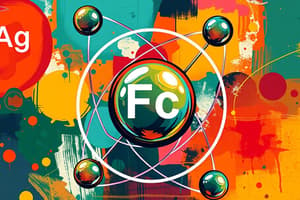Podcast
Questions and Answers
Which of the following is NOT a characteristic of elements?
Which of the following is NOT a characteristic of elements?
- Elements are the fundamental building blocks of matter.
- Each element is uniquely defined by its atomic number.
- Elements can be broken down into simpler substances by chemical means. (correct)
- All matter is ultimately composed of elements.
The atomic number of an atom is determined by the number of neutrons in the nucleus.
The atomic number of an atom is determined by the number of neutrons in the nucleus.
False (B)
What are the four main types of biological molecules?
What are the four main types of biological molecules?
Carbohydrates, lipids, proteins, and nucleic acids
The ______ of an atom is determined by the sum of protons and neutrons in its nucleus.
The ______ of an atom is determined by the sum of protons and neutrons in its nucleus.
Match the following types of chemical bonds with their descriptions:
Match the following types of chemical bonds with their descriptions:
Flashcards
Element
Element
A pure substance that cannot be broken down chemically.
Atomic Number
Atomic Number
The number of protons in an atom's nucleus.
Atom
Atom
The smallest unit of an element that retains its properties.
Molecule
Molecule
Signup and view all the flashcards
Chemical Bond
Chemical Bond
Signup and view all the flashcards
Ionic Bond
Ionic Bond
Signup and view all the flashcards
Covalent Bond
Covalent Bond
Signup and view all the flashcards
Isotope
Isotope
Signup and view all the flashcards
Study Notes
Elements
- Elements are pure substances that cannot be broken down into simpler substances by chemical means.
- They are the fundamental building blocks of matter, and all matter is ultimately composed of elements.
- Each element is uniquely defined by its atomic number, which represents the number of protons in the nucleus of its atoms.
- The periodic table organizes elements based on their atomic structure and chemical properties.
Atom Makeup
- Atoms are the smallest units of an element that retain the chemical properties of that element.
- An atom consists of a central nucleus containing protons and neutrons, surrounded by orbiting electrons.
- Protons have a positive charge, electrons have a negative charge, and neutrons have no charge.
- The number of protons in an atom determines its atomic number.
- The mass number of an atom is determined by the sum of protons and neutrons in its nucleus.
Building Blocks of Biology
- Atoms combine to form molecules, which are the fundamental building blocks of all biological molecules.
- Biological molecules include carbohydrates, lipids, proteins, and nucleic acids.
- These molecules perform essential functions in living organisms.
Characteristics of atoms
- Atoms are electrically neutral; the positive charge of the protons in the nucleus is balanced by the negative charge of the electrons orbiting the nucleus.
- Atomic size varies considerably depending on the element.
- Atomic mass is largely determined by the mass of the protons and neutrons in the nucleus.
- Isotopes are atoms of the same element with different numbers of neutrons, resulting in varying atomic masses.
- The position of an element on the periodic table reflects its underlying electronic structure.
- The arrangement of electrons in electron shells surrounding the nucleus dictates the chemical reactivity of an atom, and defines the atom's tendency to gain or lose electrons during chemical bonding.
Bonds
- Chemical bonds are the forces that hold atoms together in molecules.
- Different types of chemical bonds include ionic bonds, covalent bonds, and hydrogen bonds.
- Ionic bonds form between atoms with significantly different electronegativities, resulting in the transfer of electrons and the formation of ions.
- Covalent bonds form when atoms share electrons.
- Hydrogen bonds are weak attractions between a slightly positive hydrogen atom in one molecule and a slightly negative atom in another molecule, typically oxygen or nitrogen. These bonds often play a critical role in the structure of biological molecules.
- The strength of different types of bonds significantly impacts the structure and function of biological molecules. The properties of molecules are critically dependent upon the structure, influenced by the strengths and types of bonds within the molecules.
- Understanding the characteristics of bonds, such as their strength, polarity and directionality, is pivotal for understanding the formation and properties of biological macromolecules.
Studying That Suits You
Use AI to generate personalized quizzes and flashcards to suit your learning preferences.




